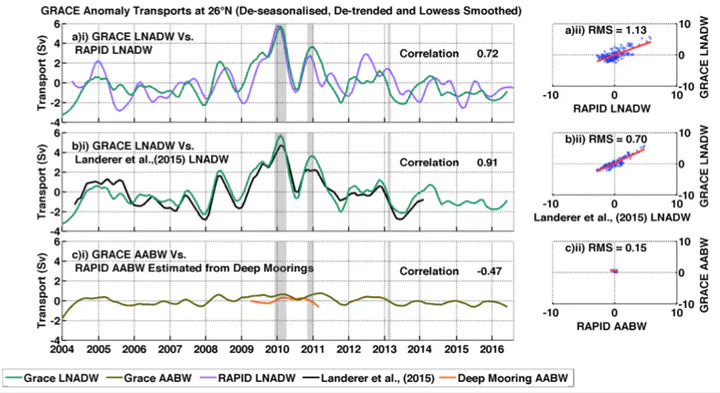Variability and Transport Methodology of the Atlantic Meridional Overturning Circulation at 26°N

Abstract
The importance of The Atlantic Meridional Overturning Circulation (AMOC) resides in its associated poleward movement of heat (Bryden et al., 2012). Projections of AMOC decline (IPCC, 2013) motivate continued investigation into AMOC transports. The AMOC baroclinic component has been monitored by infrequent hydrographic sections at 24.5°N and, since 2004, twice-daily measurements by the RAPID mooring array at 26°N. AMOC barotropic transports can be determined using bottom pressure data measured each month by the GRACE satellite system since 2003. During the first 4 years of RAPID observations the overturning circulation was, on average, 2.7 Sv stronger than in the subsequent 4 years (Smeed et al., 2014). RAPID transports also reveal downturn events, occurring in 2009-10, 2010-11 and 2013, typified by weak northward Ekman transports and weak southward transports below 3000m. Transports from hydrographic sections show contrasting results, with stronger overturning in 2010 than 2004. Causes for the discrepancy are explored. Hydrographic data are found to be inconsistent with the scale of flow variation captured by current meter absolute transports at the western boundary, an important region of large and highly changeable flow. The RAPID AMOC calculation is altered to include the deep western boundary current, allowing evaluation as to whether it carries a signal relevant to the observed AMOC weakening since 2004. An extra profile of mooring data located 500 km from the western boundary is added to the RAPID AMOC calculation and a shallow reference level is applied in the western region. Results indicate that the strong and highly variable western boundary baroclinic flow is accompanied by a strong and highly variable barotropic response. However, barotropic flow is difficult to observe directly and is therefore substituted with compensation transports that are calculated as a residual to ensure mass balance and distributed uniformly over the basin in the AMOC calculation. GRACE satellite data are employed to estimate deep barotropic transports, particularly below 5000 m. Potential is found for GRACE data to identify longitudinal variation in monthly-averaged barotropic transports across the basin. A future area of investigation lies in uncovering a method of non-uniform distribution of compensation transports, using GRACE-derived bottom pressure, in the RAPID AMOC calculation to fully incorporate the high-frequency western boundary flow and improve knowledge of the deep transports that counterbalance upper ocean changes. This study aims to improve understanding of AMOC measurements and trends at 26°N, which have implications for how the larger circulation is viewed.